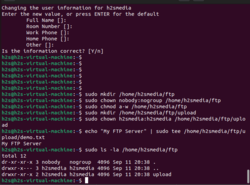today's howtos
-
How to install VSFTPD to Setup FTP Server on Ubuntu 22.04
This tutorial is to know how we can install, config, set up and use the VSFTPD FTP server on Ubuntu 22.04 LTS Jammy JellyFish using the command terminal.
Vsftpd is an FTP server that is very consciously designed for security. For example, the program checks its configuration and the rights of all files it is to access before starting and refuses to start if it is configured incorrectly.
Furthermore, Vsftpd is the only FTP server in the “main” branch of the Ubuntu distribution, i.e. it is guaranteed to be maintained and provided with security updates. This does not have to be the case with other FTP servers from the “universe/multiverse” branches.
Last but not least, Vsftpd is very easy to set up. Without cumbersome configuration files, you can let the local users access their home directory or set up anonymous FTP access. Apart from this open source FTP server; PureFTPd and ProFTPD are some other popular names in the category.
-
convert a curl cmdline to libcurl source code | daniel.haxx.se
The dash-dash-libcurl is the sometimes missed curl gem that you might want to know about and occasionally maybe even use.
-
Redis XTRIM
Redis streams are an append-only data structure that provides a set of highly efficient read and insert operations with a memory-efficient storage mechanism. Internally, the Redis streams use a Radix tree data structure which is a space-optimized tree with high memory efficiency.
Redis streams store data as a list of entries where each entry consists of key-value pairs. At a low level, these entries are packed into macro-nodes, as shown in the following.
-
How to Burn ISOs with Balena Etcher on Linux
In this tutorial you will learn how to burn an ISO image to your USB flash drive or harddisk. Balena etcher is a cross platform app that allows you to create bootable devices in a matter of seconds, it is very easy to use and doesn't require any technical knowledge, so feel free to try balena etcher.
Since balena etcher is a cross platform app, you can run in Linux, Windows and MacOS. However, in this tutorial we're going to explain how to use it on Linux.
-
How to Install Fish Shell with Starship on Linux distributions - TREND OCEANS
In our previous posts, we already discussed that bash is not the only shell to use in a Linux system, and for this reason, we have come up with the zsh shell, but on the internet, the fish shell is highly appreciated for its simplicity.
When I say simplicity, then I mean it because when you install the fish shell on your system, most of the basic functionality of the shell takes place automatically, like tab completion, which is one of the prime features of this shell. Not only that, but you will also find syntax highlighting, which will alert you that you are typing the wrong program name in the “red” color. If it’s a valid program, then the colour will turn blue.
Moreover, you can use some of the built-in commands and keybindings which take the fish shells to different levels in terms of flexibility, like my favourite options for navigating around previous and next directories using prevd and nextd, or I can use the shortcut Alt + Left arrow and Alt + Right arrow for the same.
-
How to Install Inkscape on Linux Mint 21 LTS
Inkscape is a fantastic vector graphics editor that is free and open-source. It is primarily used to create Scalable Vector Graphics, but it can also import and export other formats. Inkscape is great for anyone who wants to get creative with their artwork, as it has many features that bring any design to life. These features include scalability and the ability to import/export so the artwork can be used in any vector graphics program. Inkscape can also render primitive vector shapes and text, making it even more versatile. Thanks to its wide range of capabilities, Inkscape is a potent tool for anyone looking to create unique vector graphics.
In the following tutorial, you will learn how to install Inkscape on Linux Mint 21 LTS release series using two installation methods of APT or Flatpak to install the graphics editor using the command terminal.
-
How to reconfigure Ceph storage in OpenShift Data Foundation | Enable Sysadmin
Installing OpenShift Data Foundation (ODF) with external Ceph storage is pretty straightforward: some clicks on the OpenShift console, execute a script inside the Ceph cluster, and you are ready to go. Changing those configurations is not as clear.

